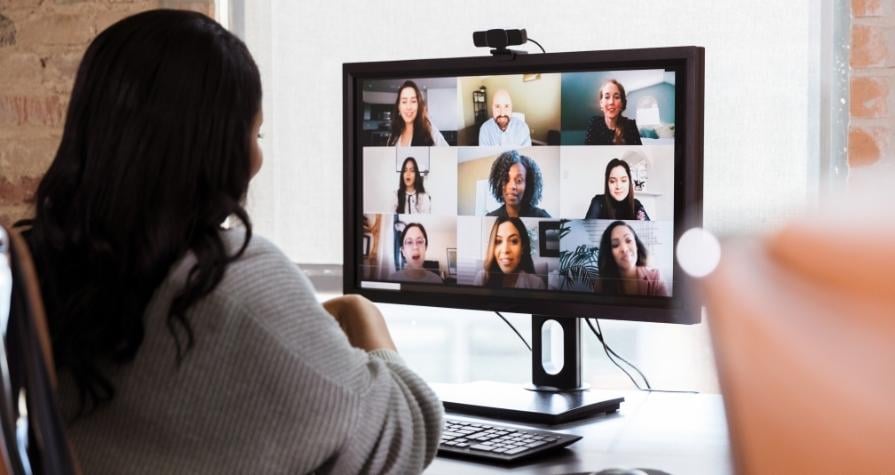The Definitive Guide
to Remote Selling:
How Sales & Marketing Can Elevate the Virtual Buyer Experience
Today's buyer has become more digital and self-servicing—making it more challenging for sellers to understand when a buyer is ready to purchase. Even more so in a virtual sale. So what’s the solution? A digital environment where buyers and sellers can virtually share resources and collaborate as the buying journey progresses.

Table of Contents
Introduction
Engaging with today's digital buyers is more challenging than ever before—and every interaction a seller has must add value. The future of sales is in immersive and personalized digital experiences that allow for collaboration between the seller and buyer.
Confident sellers lead to confident buyers who can make the right purchase decisions for their business. Do your sales and marketing teams have the right tools in place to engage modern buyers?
"We continue to find new ways to use Modus to have better conversations with contractors, as well as our dealers—who then have better conversations with their customers. There’s always another idea, and the Modus team has been great at helping us make them come to life."

What Buyers Want
You’ve heard it before—the way today’s buyers navigate the buying process has changed dramatically from years past. And in many cases, sellers didn’t have the luxury of idly watching that change happen.
So what’s the biggest shift we’ve seen, you ask? Well for starters: Today’s buyers make their way through 90% of the buyer’s journey before talking to sales. This means that much of their buying experience is done virtually—without input from your sales team.
From social advertisements to web research and email consideration, buyers have many more touch points throughout the process than ever before. And digital research continues to play a large part in how buyers buy. This means that B2B buyers want to conduct their own research and consume content from a variety of sources to inform their decisions, without conversations with sales.
While they may be less likely to depend on sales representatives to make decisions, it doesn’t mean they don’t engage at all. It just means that they require more information than before to make a purchase. And with many different types of buyers on their buying journeys, it helps to be ready for them all.

Why Virtual Selling—and Buying—Is on the Rise
The massive shift in our lifestyles in the last two years cannot be ignored. Because of the pandemic, we have become even more attached to our digital devices, relying on them for everything from consuming news to managing school and work to connecting socially. This digital shift has also significantly impacted how people buy and sell.
While face-to-face interactions are making a comeback since the onset of COVID-19, sellers can’t assume that it’s how the majority of buyers prefer to shop. According to McKinsey:
“More than three quarters of buyers and sellers say they now prefer digital self-serve and remote human engagement over face-to-face interactions—a sentiment that has steadily intensified even after lockdowns have ended.”
And with a whopping 83% of employers reporting that even after today's crisis has passed, they plan to put more flexible work policies in place, such as allowing more people to work from home or letting them adjust their schedules. This changes the game for sellers, allowing them to create digital content experiences through remote and virtual selling.
So, what does this mean for virtual sellers?
“More than three quarters of buyers and sellers say they now prefer digital self-serve and remote human engagement over face-to-face interactions—a sentiment that has steadily intensified even after lockdowns have ended.”

Let’s Define What “Virtual Selling” Is. And Where Sellers Should Start.
COVID-19 isn’t the only reason we’ve seen a rise in digital preferences. Let’s face it—sales has been fighting this uphill battle since the introduction of the Internet. A quick online search can surface your top competitor’s content easier than ever before. On the seller’s side, video calls and live chats have replaced the majority of in-person sales conversations and related sales activities. And sales presentations and collateral are now almost entirely digital, not paper.
Gartner defines virtual selling as “The collection of processes and technologies by which salespeople engage with customers remotely with both synchronous and asynchronous communications. These communications are often replacing in-person, face-to-face sales conversations and have become increasingly prevalent in response to the COVID-19 pandemic.”
With all the aforementioned changes in buying and selling, sales teams must now learn how to be successful specifically in virtual interactions with buyers. Sales teams must be welcomed to this new and better way to sell—and be allowed to train to do so in a fully digital setting.
Virtual Selling Best Practices to Engage Buyers
This new way of selling doesn’t mean that sales teams have to be locked out of the process. Instead, they have to establish a credible reason to the buyer why they should be involved— and that means having tangible value to add.
If you want to master virtual selling, buyer engagement is a must to make a solid impression. You must give your buyers something to see and click on that adds value to their buying journey and delivers them somewhere to leave their comments in real-time. Your buyers need a way to send messages to other stakeholders, and somewhere to interact with you and your content.
So what’s the answer? Enter the digital sales room: A digital meeting space where sellers share relevant content with buyers for meaningful engagement that drives the sales process. It gives both sellers and buyers a platform to collaborate—virtually, from anywhere.
But a digital sales room is only the tip of the iceberg. Sellers still need to follow several virtual selling best practices, outlined below.
1. Invest in remote selling skills.
Sales is a role rooted in traditional practices. While it usually involves a certain timeline of events and follow-ups, this new environment means that education is key. There is a multitude of resources available for sales individuals on how to embrace this new way of selling and the best practices that come with it.
A huge advantage of remote selling is that it can make sellers more productive as long as they know how to manage and maneuver the challenges. Take some time to read and dig into related resources to learn how to adapt to remote selling and how to build on the skills needed to be successful.
2. Discover ways to transition from in-person sales to remote selling.
The in-person sales process of the past limits the number of interactions you can have in a day, including research, travel to and from meetings, and other activities that steal precious minutes in the day. Remote selling helps to expand your reach, increase deal closings and profits, and simplify the process through a digital platform.
Make note of ways you can update and transition your process to help you move toward a virtual selling space. These can include tactics like:
- Do your buyer research ahead of time to give yourself ample preparation.
- Prepare interactive content and presentations to keep buyers engaged.
- Amplify your selling personality to ensure your genuine self comes through.
- Always have your video on to establish a connection.
- Actively listen and take notes to avoid distractions that inevitably pop up during your meeting.
- Invest in the right digital technology to increase your comfort levels.
Virtual selling doesn’t have to make sellers (or buyers) uncomfortable. Jot down your own list of items that you want to adapt and finesse as you grow into this new selling landscape.
3. Build rapport with your buyers through virtual selling.
Some sellers may think that not being “face-to-face” in the traditional, more physical sense can be a downfall to selling. However, that’s not the case. According to Zoom, a survey of over 700 users of the video collaboration platform shows that video can improve communication.
A few key points to keep in mind:
- Clear and engaging communication is key. This is true with any relationship-building, but increasingly important when you have a plethora of distractions all around you—and your buyer—that you can avoid in-person (i.e. children or other family member disruptions, notifications on your computer and phone, etc.).
- Active listening throughout your conversation or meeting allows you to gather bits of information to help make thoughtful and strategic recommendations. It also helps fuel personal conversations at the beginning and/or end of your calls when you want to chat about other things outside of the selling process.
- Follow up via different lines of communication to stay top-of-mind. If you read an article or see a post on LinkedIn that reminds you of one of your buyers, send it to them and let them know you’re thinking of them. Drop them a note to say hello, happy birthday, or congratulations. These small sentiments help to build rapport and trust versus being just another salesperson.
4. Find new ways to reach buyers virtually.
Virtual selling has offered many salespeople the gift of time to invest in deepening their relationships with prospects and customers. Without in-person interactions, virtual sellers can continue to strengthen relationships with those that they’re connected with already—but what about reaching new prospects?
Networking has always been a tried-and-true practice for expanding networks. Those natural conversations at happy hours, industry conferences or trade shows haven’t happened the way they used to. While these types of events are making a comeback, they still aren’t in full force. Instead, consider:
- Using social networks as a way to stay in touch. Just as you would reconnect with a prospect at an event, for example, you can still catch up via LinkedIn or other professional ways of communication.
Focusing on being found. Instead of putting 100% of your effort into reaching out and networking virtually, take some of that time to invest in yourself. Make your professional presence known by sharing articles, news or industry updates, or draft a thought-provoking piece yourself. Not only will you stay top-of-mind for those that know you, but you’re also bound to start a conversation or make your way into a new prospect’s feed.
5. Establish remote selling KPIs.
Gone are the days of a typical 40-hour workweek. Now that work-from-anywhere is permeating more workplaces, organizations are adopting new work processes and standards. While this may be true, salespeople have always operated a little differently—working around their prospects’ and customers’ schedules to accommodate meetings and conversations.
Almost every action a sales team member makes can be tracked and optimized. This isn’t news, but as more and more interactions become remote, digital selling KPIs should be adjusted to account for the changes. HubSpot suggests eight metrics that remote salespeople should be measuring per rep, including KPIs like:
- Call volume.
- Closed-won deals.
- Revenue generated.
- Outreach activities.
- Sales tools used.
- Leads generated from various channels.
- Percentage of time spent on sales activities.
What Does Remote Selling Mean for Marketers?
We’ve talked about how remote selling has impacted sellers. But what about sale’s right-hand team, marketing?
A digital environment doesn’t mean that marketers have to sit back and let sales do their own thing. Instead, relying on digital sales rooms allows marketing to distribute relevant content to sellers. This provides virtual sellers the opportunity to consume and then share that relevant content with potential buyers at the appropriate time in the virtual sale. Marketers can create digital content experiences that help their sellers share relevant content with buyers before a face-to-face conversation occurs.
A major marketing perk of digital sales rooms is that they collect data on seller and buyer actions and engagement. This means that marketers and sales leaders can see which content sellers are sharing with buyers, and which pieces are high (and low) performers. The golden ticket: Marketing can create, hone and optimize content based on real interactions and performance data in a digital sales room.

What Does Remote Selling Mean for Buyers?
The modern buyer is demanding a different type of sales experience. This new type of sales experience is new and different to buyers—but it can also work in their favor. Digital sales rooms mean that buyers have a specific place to find and consume digital content and have meaningful and memorable engagements with your brand.
Virtual selling has empowered self-serve buying. This process is more simplistic, collaborative, relevant and buyer-focused than ever before. Digital sales rooms streamline the seller and buyer experience with a centralized location for easy access to content, stakeholders and communications regarding a purchase that drives higher buyer engagement.
Digital sales rooms empower buyers. Buyers want more autonomy in the buying process, and they prefer to investigate products and services on their own time. A digital sales room helps to rethink buyer enablement. As a salesperson, you can help build a perpetual demand cycle that combines virtual sales conversations with the digitally driven self-service experience that buyers are beginning to demand—and the opportunity to build a productive, more consultative relationship.
Modus Can Help You Drive Virtual Sales Success with a Digital Sales Room.
Digital sales rooms are essentially what sellers use to meet and collaborate with prospects and customers. It combines sales enablement tools with self-service buyer enablement tools. Think of a digital sales room as your virtual meeting room to drive buyer engagement—just more visually, more interactively, more engagingly, more immersively—and …. more effectively.
The key to a digital sales room is that it’s customized. Each buyer and buying group gets its own personalized virtual meeting space. All of the resources, relevant content, buyer comments and other interactions in their site become a record of engagement over the lifecycle of the deal. Notifications and analytics deliver buyer intent to sellers and help align sales and marketing on which content is most effective.
For virtual selling to be effective, you must be memorable, engaging and focused on the needs of your buyers. Modus is a simplified sales enablement platform that can help you stay connected. See a demo of Modus and learn how a digital sales room can help you engage buyers and drive more sales than before.
- Engage your buyers.
- Accelerate and close deals.
- Align sales and marketing teams.
- Increase ROI.
- Boost sales efficiency + effectiveness.
- Build rep + buyer confidence.
